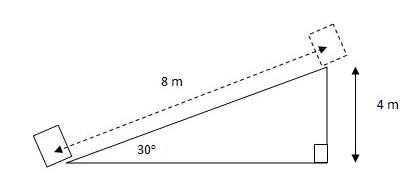Workbook Answers: Genetics p181-82
4.a) mRNA
b) tRNA
c) mRNA
d) mRNA
5. ribosome
6. the DNA bases of the gene
8. AUG = met
ACU = thr
GAU=asp
CGU = arg
UCC = ser
GAA = glu
UAA = stop. (protein is complete)
Genetics pages 188-190
3. The parents are Bb and Bb, where B = black , which would presumably be dominant over brown(b).
In real life, the genetics of hair colour are more complicated than this question pretends.
4. a) heterozygous
b) orange
c) yellow
5. You need to have both alleles of the recessive gene.
6. a) phenotype
b) genotype
c) phenotype
d) BOTH
11.
GL |
Gl |
gL |
gl |
|
Gl |
GGLl |
GGll |
GgLl |
Ggll |
Gl |
GGLl |
GGll |
GgLl |
Ggll |
gl |
GgLl |
Ggll |
ggLl |
ggll |
gl |
GgLl |
Ggll |
ggLl |
ggll |
a) 2 ggll
b) 6 GGLl or GgLl
 p46
p46
1.
3. Mass depends on the number of atoms, which would not change.
4. a) weight = mg = 60 kg * 9.8 m/s2 = 588 N
b) on the moon g = 1.6
weight = mg = 60 kg * 1.6 m/s2 = 96 N
p 48
2. a) F = 30*cos35 = 25 N
b) The vertical force (30 sin 35 = 17 N) is less than the 30 N weight of the box.
3. a) effective force = 784* sin 30 = 392 N
b) It would increase since the sine of larger angles is a bigger number.
4. effective force = 30N *cos 40 = 23 N
 |
Here’s why: cos 40 = adj/hyp = effective force/30N.
Cross multiply: effective force = 30 N * cos 40
p 43
Kinetic energy: energy of motion depends on mass and square of velocity
Gravitational Potential Energy: energy due to gravity and position
p 47
Work is the product of an applied force times the distance in the direction of the applied force.
p 49 Work
6. lifting a box
pulling a wagon across the street
7. W = F*d = 8N * 2000 m = 16 000 Nm = 16000 J
8. D only ( no movement or deformation)
1. 30 km/h (1000m/km)(h/3600 s) = 8.33 m/s
K.E. = 0.5mv2 = 0.5(45)( 8.33 m/s) = 1560 J
2. P.E. = mgh = 0.5 kg(9.8)(0.3 m) = 1.47 J
3. a) KE
b) PE (he’s not moving yet, if he’s “poised”)
c) KE
d) PE
4. a) 80.5 J (first convert to m/s)
b) 3.6 J
c) mechanical = total energy = 80.5 + 3.55 = 84.1 J
The questions were:
5.  a) An Easter rabbit pulls the wagon with a force of 35 N, and the rope makes an angle of 30o. Use the effective force and the acceleration of 2.0 m/s2, to find the total mass of the Easter eggs and wagon.
a) An Easter rabbit pulls the wagon with a force of 35 N, and the rope makes an angle of 30o. Use the effective force and the acceleration of 2.0 m/s2, to find the total mass of the Easter eggs and wagon.
b) Use the effective force to calculate the work done by the rabbit as he drags the wagon 2 m before reaching a constant speed.
7. A mass is dropped from a height of 20 m. Find its velocity at a height of 10 m by using the conservation of energy principle.
Answers:
5. a) Feffective = Fapplied*cos(angle) = 35 *cos(30) = 30.3 N
F = ma
30.3 N = m(2)
m = 30.3/2 = 15.2 kg
b) W = F*d
= 30.3 N(2m) = 60.6 Nm = 60.6 J
6. W = F*d
= 10 N(2.30m) = 23Nm = 23 J
7. Total energy at 20 meters = all potential energy (iniitally the mass has no velocity)
=mgh = x(9.8)(20) = 196m, where m = mass
At a height of 10 meters, it will have some potential energy: m(9.8)(10) and kinetic energy = 0.5mv2.
so since total energy does not change:
196 m = 98m + 0.5mv2.
Cancel m:
196 = 98 + 0.5v2. Bring 98 over and divide by 0.5:
196 = v2.
v = 14 m/s
Let's have a closer look at the example we did in class:
The questions were:
d) How much work is done to raise the 12 kg from the bottom of a ramp? The slanted distance travelled is 8.0 metres. Use the applied force to work it out. The angle is 30o.

We could have argued that the effective force that it slides down with does not depend on the weight's location.
That force we learned = mg sinO .That implies that if we are at the bottom of the ramp, the force needed to push it up will be the same
F = 12(9.8)sin30 = 58.8 N
W = F*d = 58.8 (8)= 470.4 J
e) Redo (d) using the idea of potential energy.
The energy needed to push it up the ramp should equal then energgy required to lift it straight up becuase in both cases it attains the same potential energy: Use trig to get the height and then:

W = Ep = mgh = 12(9.8)(4)= 470 .4 J
Of cource if you divide this 470 .4 J value by 8m, you obtain the same force of 58.8 N, which we obtained from mg sinO!